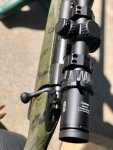ishootlittlebucks
Senior Member
I have a few Zeiss Conquests that I like a lot in pretty low light. What I have found that works best, for me anyway, is to use a set of binos to decide if it's what you can shoot, then just use the scope to shoot. I don't have expensive binos. Even with them I have an easier time seeing horns and counting points than with a scope. I can only imagine what a good set could accomplish. I think it has something to do with using both eyes.

